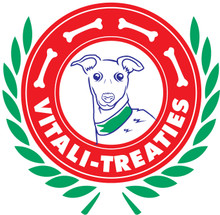 Loading... Please wait...
Loading... Please wait...
We offer free shipping
on 2 containers or more
Successful Treatment of Your Diabetic Dog
Posted by Kameron Carlson on 20th Apr 2014

Your pet has been diagnosed by your veterinarian with diabetes mellitus (sugar diabetes)!Now what?
The following is some basic information you should know to successfully treat your dog’s diabetes. Diabetes can be a difficult and unpredictable disease to manage. By employing the techniques below the treatment can be made less frustrating.
Most dogs are Type 1 diabetics. This means that special cells in a gland called the pancreas are no longer producing insulin.Insulin is necessary to facilitate the use of the fuel, glucose, by the body’s cells. It is necessary for survival and must be given by injection.Insulin needs to be refrigerated; always be aware of the expiration date on the vial.
TYPES OF INSULIN:
Humulin-N®:this is a human insulin available without prescription at local pharmacies. Humulin® is a U-100 product meaning there are 100 units of insulin per milliliter (ml) or cubic centimeter(cc). So there are 1000 units in a 10 cc vial.Prices vary considerably so shop around. There are few, if any, mom’n’pop pharmacies anymore, but we checked some of the big guys and the prices ranged from $47.99 to $124.89 per vial. Syringes used must be calibrated for U-100 insulin. The syringes should have a 29 or 31 gauge, ½” ultra-fine needle – ½” to be certain of injecting under the dog’s skin.Humulin-N® should be administered every 12 hours.
Vetsulin®:This is insulin made for dogs and available only from your veterinarian.Vetsulin® is a U-40 product (40 units per cc) meaning there are 400 units in a 10 cc vial.If your veterinarian opts for this insulin make sure he or she provides syringes calibrated for U-40.Like Humulin®, Vetsulin® should be given every 12 hours.
THE PROCESS:
Regulation:This refers to the process performed by your vet involving the checking of blood sugar levels at certain times during the day to determine the correct dose for your dog.The goal is to reduce blood sugar readings to more normal levels.While there is a “textbook” starting dose (more on this later), the final dose can vary from dog to dog.This is a necessary step made to avoid some of the possible complications of the disease.
Nutralin®:A nutritional supplement developed by Vintek Nutrition® (www.vinteknutrition.com ) in 2009. Experience by Dr. Sam Lukens and a number of other veterinarians determined that Nutralin® made the regulation process much smoother, reduced the amount of insulin necessary per dose and reduced the incidence of diabetic complications: wild blood sugar swings, cataracts, weight loss, skin disease and poor coat quality, frequent urinations and excessive thirst.
TREATING DIABETES: Most folks are horrified at the thought of having to inject something into their beloved pet.(their personal experiences with injections being less than positive)After removing the insulin from the fridge, gently roll the vial between your hands to suspend the insulin in the carrier. Do NOT shake the vial.If the dose is 10 units, say, draw back the plunger to the 10-unit line taking in air.Insert the needle into the rubber stopper and inject all the air.This is done to prevent a vacuum in the vial by replacing the 10 units being drawn up with an equal volume of air.Withdraw the plunger to the 10 unit line taking up the insulin.The injection is best given at the scruff or base of the neck slightly to one side or other of the midline. Pick up the skin with one hand to make a sort of “tent” into which the drug in injected.Do not “baby” the needle into the skin, a quick thrust is better and less noticeable. (don’t poke yourself!) Be sure to insert the needle all the way to penetrate the skin completely.The hub of the needle will stop the forward movement. The drug won’t work if all or part of the dose is injected INTO the skin.If you have another person in the household it is helpful to have him or her distract the dog by talking or, better yet, holding a Nutralin® in its face heightening its anticipation of the goodie.Within a few days the dog will not even notice you injecting and look forward to the Nutralin® as a reward for taking the shot.
INSULIN DOSE:The usual starting dose is about ¼ unit per pound of body weight. Thus, a 20 lb. dog would start at 5 units; 40 lb. at 10 units, and so on. Your vet should help you with the arithmetic.Understand that this is a starting dose and your vet will need to run tests as in “Regulation” above to determine the proper dose.
FEEDING:It is best to have your dog on scheduled feedings, giving half the daily ration shortly after each shot.Of course, you should be giving the proper Nutralin® dose at this time as well to smooth the usage of the insulin you gave.Avoid the giving of “dog treats” during the day as this can adversely affect blood sugar levels. Blood sugar is made primarily from the carbohydrates in food, so if you can find a diet that is lower in carbs this will be beneficial. The addition of fiber to the diet – fiber is a complex carb – is also a good thing.We often recommend Kellogg’s Bran Buds® cereal, a Tb or two, added to the food.Some dogs will also eat canned pumpkin which is an excellent fiber source.Fiber seems to slow the sudden rise in blood sugar.
This entire process seems a bit overwhelming at first, but with professional veterinary counseling and some practice it’ll be fine.We feel strongly that ALL diabetic dogs will benefit from the addition of Nutralin® to the treatment regimen.Please visit our web site: www.vinteknutrition.com .It contains more educational material about sugar diabetes as well as how to contact Dr. Lukens or Vintek Nutrition®. We look forward to hearing from you if you need our assistance.
Thank you
Samuel Lukens, DVM
Twitter - #VintekN
Recent Posts
- » Sterling Coat and Vitali Treaties: The Essential Supplements for Your Dogs. AI - GROK search 4/8/25.
- » Nutralin: The Essential Supplement for Diabetic Dogs. AI - GROK3 Search Results "Nutralin® and DiaTreaties® by Vintek Nutrition." 4/8/25
- » Overall Pick - Amazon's Choice - Vintek Nutrition's - Nutralin for Diabetic Dogs
- » Vintek Nutrition featured in Moozthemes "Top 10 Natural Supplements for Diabetic Dogs" May 2023
- » Dog Owners: New Payment Gateways Added to Vintek Nutrition Website


















